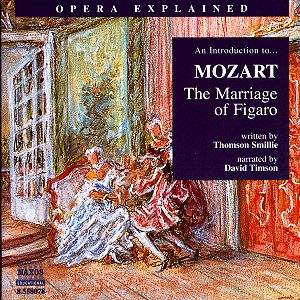In my review,
elsewhere on this site, of ‘An Introduction to Die Fledermaus’,
I own to being converted to the scholarship that is present in
this series and that offer, I believe, illumination for even the
most ardent opera buff. In this introduction to ‘Figaro’ the erudition,
if I might put it that way without deterring teachers or newcomers
to the work, is a bit slow getting off the ground with barely
relevant, but I suppose inevitable, references to the film ‘Amadeus’.
However, matters are quickly back to normal, with reference to
Mozart’s adolescent works, ‘Lucio Silla’ and ‘Ascanio in Alba’
and that first real masterpiece ‘Il Seraglio’. In comparing Belmonte’s
aria from the latter work with Tamino’s from the ‘Magic Flute’,
of nine years later, the narrative makes an unusually big jump
(tr.3). Moving on to the Mozart-Da Ponte operas, there is a good
analysis of Don Giovanni, well illustrated by musical examples,
and concluding with the last of the triptych, ‘Cosi’ which is
later analysed in more detail (tr. 5). The narrative on the Beaumarchais
trilogy of plays and their relationship with ‘Figaro’ and Rossini’s
‘Barber of Seville’, of which we get several musical illustrations,
is most interesting (tr.6), while being a little harshly dismissive
of Paisiello’s opera of the same name.
With the more analytical section out of the way
the succeeding tracks (7-15) concentrate on the opera in question,
‘Figaro’. There are illuminating and informative comments such
as the role and difference between recitative (moving the plot
forward) and aria (comments on the situation). The evolution of
the plot and the relevance of the various characters is clearly
outlined, and in this context I must say the explanation of the
goings-on in act 4 (trs. 14-15) is masterly. Sometimes I found
the musical illustrations rather too brief, and whilst they are
all in the original language I did wonder why the title wasn’t
also. The Naxos recording used for the musical illustrations is
rather over-reverberant and not sung with particular distinction.
However, these are not important matters in this context.
This CD has much to offer be it to the opera
buff or to someone dipping a tentative toe in the water. There
are few more enjoyable works to start an opera-loving career than
this effervescent comedy and so much within it that can be overlooked
through familiarity.
Robert J Farr
See also review
by Colin Clarke
